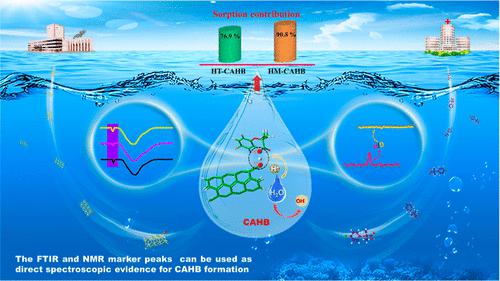当前位置:
X-MOL 学术
›
Environ. Sci. Technol.
›
论文详情
Our official English website, www.x-mol.net, welcomes your
feedback! (Note: you will need to create a separate account there.)
Direct Spectroscopic Evidence for Charge-Assisted Hydrogen-Bond Formation between Ionizable Organic Chemicals and Carbonaceous Materials
Environmental Science & Technology ( IF 10.8 ) Pub Date : 2022-06-21 , DOI: 10.1021/acs.est.2c00417 Jinlong Zhang 1, 2 , Hao Zheng 3 , Xiaoyun Li 1, 2 , Nana Li 1 , Yifan Liu 1 , Tao Li 1 , Yue Wang 1 , Baoshan Xing 4
Environmental Science & Technology ( IF 10.8 ) Pub Date : 2022-06-21 , DOI: 10.1021/acs.est.2c00417 Jinlong Zhang 1, 2 , Hao Zheng 3 , Xiaoyun Li 1, 2 , Nana Li 1 , Yifan Liu 1 , Tao Li 1 , Yue Wang 1 , Baoshan Xing 4
Affiliation

|
The direct evidence for the formation of charge-assisted hydrogen bond (CAHB) between the charged groups of ionizable organic chemicals (IOCs) and carbonaceous materials with similar proton affinity remains elusive. We therefore selected three pharmaceutical contaminants (PCs) as representative IOCs to provide the direct evidence of CAHB formation between IOCs and functionalized carbon nanotubes (CNTs) and its intensity/contribution to PC sorption on CNTs by NMR, FTIR, and DFT analyses. Sorption of PCs on functionalized CNTs resulted in the FTIR characteristic peak that appeared at a higher frequency (3787 cm–1) and the 1H NMR characteristic peak that emerged at an extremely low-field region (<18.0 ppm), which can be used as the direct spectroscopic evidence for CAHB formation. Both homonuclear CAHB (HM-CAHB, e.g., [O–H···O]−) and heteronuclear CAHB (HT-CAHB, e.g., [N+–H···O–]/[O–H···N]+) exhibited a much higher sorption energy (|Eads| ≥ 56.24 kJ/mol) than ordinary hydrogen bond (OHB, |Eads| ≤ 6.136 kJ/mol), leading to a greater sorption contribution (HM-/HT-CAHB ≥ 42.3%, OHB ≤ 36.5%) and irreversibility (hysteresis index: HM-/HT-CAHB ≥ 1.69, OHB ≤ 0.43) of PCs on CNTs. This work presents the direct evidence for CAHB formation between IOCs and CNTs, which is significant for understanding and predicting the environmental fate and risk of IOCs, thus providing new insights for controlling their pollution using specifically designed carbonaceous materials.
中文翻译:

可电离有机化学品和碳质材料之间电荷辅助氢键形成的直接光谱证据
可电离有机化学品 (IOC) 的带电基团与具有相似质子亲和力的碳质材料之间形成电荷辅助氢键 (CAHB) 的直接证据仍然难以捉摸。因此,我们选择了三种药物污染物 (PC) 作为代表性 IOC,以通过 NMR、FTIR 和 DFT 分析提供 IOC 和功能化碳纳米管 (CNT) 之间形成 CAHB 及其对 CNT 上 PC 吸附的强度/贡献的直接证据。PC 在功能化 CNT 上的吸附导致 FTIR 特征峰出现在更高的频率 (3787 cm –1 ) 和1H NMR特征峰出现在极低场区域(<18.0 ppm),可作为CAHB形成的直接光谱证据。同核 CAHB (HM-CAHB, eg, [O–H···O] - ) 和异核 CAHB (HT-CAHB, eg, [N + –H···O – ]/[O–H··· N] + ) 表现出比普通氢键 (OHB, | E ads )高得多的吸附能 (| E ads | ≥ 56.24 kJ/mol)| ≤ 6.136 kJ/mol),导致 PC 的吸附贡献更大(HM-/HT-CAHB ≥ 42.3%,OHB ≤ 36.5%)和不可逆性(滞后指数:HM-/HT-CAHB ≥ 1.69,OHB ≤ 0.43)在碳纳米管上。这项工作提供了 IOCs 和 CNTs 之间形成 CAHB 的直接证据,这对于理解和预测 IOCs 的环境命运和风险具有重要意义,从而为使用专门设计的碳质材料控制其污染提供了新的见解。
更新日期:2022-06-21
中文翻译:

可电离有机化学品和碳质材料之间电荷辅助氢键形成的直接光谱证据
可电离有机化学品 (IOC) 的带电基团与具有相似质子亲和力的碳质材料之间形成电荷辅助氢键 (CAHB) 的直接证据仍然难以捉摸。因此,我们选择了三种药物污染物 (PC) 作为代表性 IOC,以通过 NMR、FTIR 和 DFT 分析提供 IOC 和功能化碳纳米管 (CNT) 之间形成 CAHB 及其对 CNT 上 PC 吸附的强度/贡献的直接证据。PC 在功能化 CNT 上的吸附导致 FTIR 特征峰出现在更高的频率 (3787 cm –1 ) 和1H NMR特征峰出现在极低场区域(<18.0 ppm),可作为CAHB形成的直接光谱证据。同核 CAHB (HM-CAHB, eg, [O–H···O] - ) 和异核 CAHB (HT-CAHB, eg, [N + –H···O – ]/[O–H··· N] + ) 表现出比普通氢键 (OHB, | E ads )高得多的吸附能 (| E ads | ≥ 56.24 kJ/mol)| ≤ 6.136 kJ/mol),导致 PC 的吸附贡献更大(HM-/HT-CAHB ≥ 42.3%,OHB ≤ 36.5%)和不可逆性(滞后指数:HM-/HT-CAHB ≥ 1.69,OHB ≤ 0.43)在碳纳米管上。这项工作提供了 IOCs 和 CNTs 之间形成 CAHB 的直接证据,这对于理解和预测 IOCs 的环境命运和风险具有重要意义,从而为使用专门设计的碳质材料控制其污染提供了新的见解。









































 京公网安备 11010802027423号
京公网安备 11010802027423号